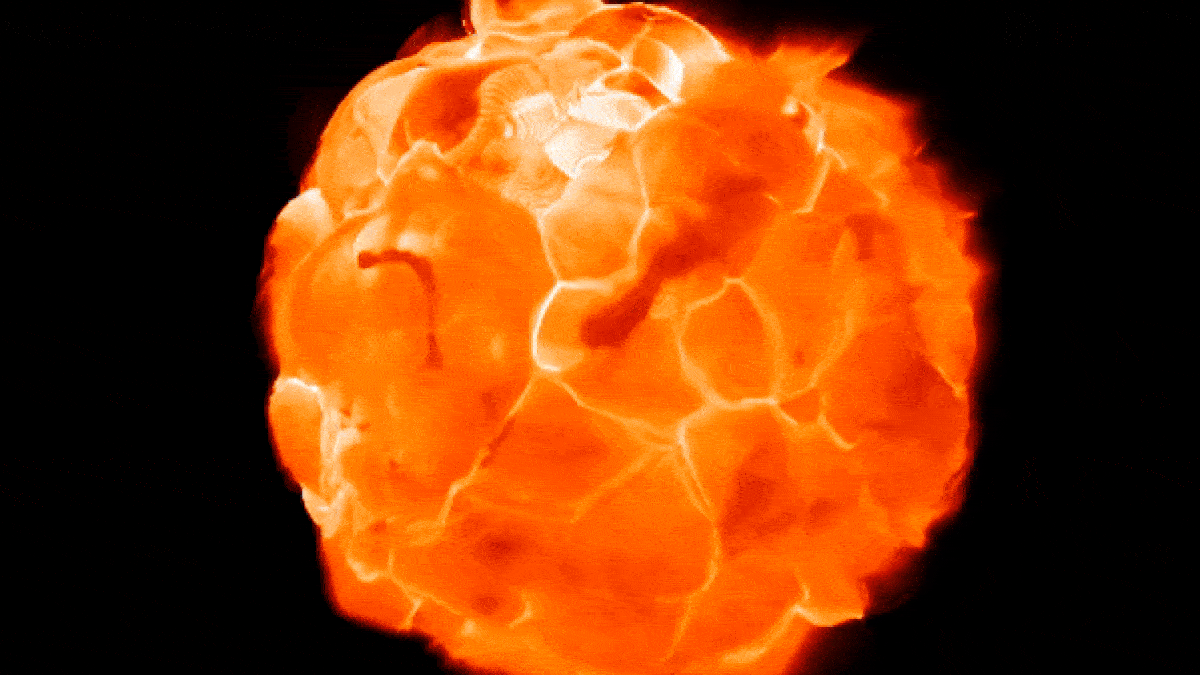Betelgeuse's mysterious spin could be a cosmic illusion caused by its enormous 'boiling' surface
The gigantic star Betelgeuse, which could be close to exploding, has previously been seen spinning much faster than it should be. However, a new study suggests that these observations were misinterpreted because of the star's shape-shifting surface.

Scientists may have finally solved the mystery of why the gigantic, dying star Betelgeuse appears to be spinning faster than is theoretically possible. What scientists previously interpreted as rapid rotation may actually be an optical illusion caused by the behemoth's "boiling" surface, a new study argues.
Betelgeuse is a red supergiant that is at least 700 times larger than the sun and 15 times more massive, making it one of the largest known stars in the universe, according to NASA. To put that into context, if you swapped the sun with Betelgeuse, the giant star would extend past the orbit of Jupiter (and Earth, along with Mercury, Venus and Mars, would be instantly incinerated).
Its extreme size also makes it one of the brightest stars in the night sky, and it can easily be spotted with the naked eye in the constellation Orion. However, Betelgeuse has been known to dim and brighten over time.
Betelgeuse is only around 10 million years old, which makes it a stellar infant compared with stars like the sun, which is more than 4.6 billion years old. Despite its young age, Betelgeuse is already on the verge of dying; it has burned up most of its reserves of hydrogen because it's so much hotter and more massive than other stars.
And when it eventually runs out of fuel — which could happen in the next few thousand years, or even within our lifetimes — it will explode in a supernova, which will shine as bright as a full moon in the sky for weeks.
Related: Here's what the supergiant star Betelgeuse will look like when it goes supernova
In 2018, observations of Betelgeuse collected by the Atacama Large Millimeter/submillimeter Array (ALMA) telescope in Chile showed that the star was spinning at around 11,200 mph (18,000 km/h), researchers wrote in a statement. This is extremely out of character for red supergiants, which are expected to spin at least 100 times more slowly.
Get the world’s most fascinating discoveries delivered straight to your inbox.
One reason for this fast spin could be that Betelgeuse previously cannibalized another star that it previously orbited. But this explanation does not sit well with everyone.
In the new study, which was published Feb. 20 in The Astrophysical Journal Letters, researchers suggested that the ALMA observations may have been caused not by the star's spinning but by massive bubbles of gas rising and falling on the star's surface.
"Stars like Betelgeuse have such drastic boiling motions on the surface that we can see those motions in action," study lead author Jing-Ze Ma, a doctoral candidate in stellar astrophysics at the Max Planck Institute for Astrophysics in Germany, told Live Science's sister site Space.com. But these motions were previously misinterpreted, he added.
In the new study, Ma and colleagues used computer simulations to model the surface of red supergiants like Betelgeuse. These simulations revealed that unlike our star, which takes the shape of a near-perfect sphere, Betelgeuse's massive surface undulates like a shape-shifting blob as giant globs of plasma, bigger than anything in the solar system, rise and fall like bubbles in a lava lamp.
When viewed using telescopes like ALMA, which are not as powerful as some other currently active telescopes, the rising motion on one side of Betelgeuse could be misinterpreted as the star spinning toward the observer, while a falling motion could look like the star is spinning away from onlookers.
The team then ran these simulations through a program that mimics the processing capabilities of telescopes like ALMA. They found that, based on the available data, up to 90% of the simulated stars could be misinterpreted as spinning, the researchers wrote in the statement.
At the moment, the boiling-surface explanation is just a theory. However, the researchers are already analyzing more detailed observations of Betelgeuse, which should be able to show if this idea is correct. If it is, it could also explain the seemingly rapid spins of several hundred other known red supergiants, the researchers wrote.
Editor's note: This article was updated on March 21 to correct an error about Betelgeuse's estimated mass.

Harry is a U.K.-based senior staff writer at Live Science. He studied marine biology at the University of Exeter before training to become a journalist. He covers a wide range of topics including space exploration, planetary science, space weather, climate change, animal behavior and paleontology. His recent work on the solar maximum won "best space submission" at the 2024 Aerospace Media Awards and was shortlisted in the "top scoop" category at the NCTJ Awards for Excellence in 2023. He also writes Live Science's weekly Earth from space series.




